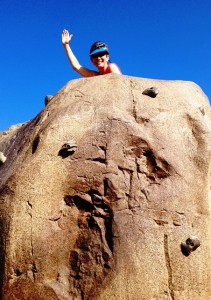There’s something that brings out the kid in us when it comes to the rock climbing walls. Maybe it’s because as kids, we always wanted to climb trees, scamper up the stairs and have the top bunk in a bunk bed.
So it’s not surprising you seen the rock climbing walls just about everywhere these days – in parks, in gyms, on cruise ships, and at festivals and fairs. But before you try to tackle that 60-foot top-rope climb (which you shouldn’t until you’ve been rock climbing for a while), there are few things you should know.
- If this is your first time to do try faux rock climbing, it should be supervised by an expert.
- As a few questions before you choose a facility to do your first climb: What kind of training does your staff have? Was it an hour-long video course or a 3-day seminar? What kinds of safety checks are done on the equipment, and how often?
- Wear a helmet. You will be tethered to a rope that should prevent a free fall to the floor, but accidents happen. Head injuries can be serious, even fatal, so protective head gear is a must.
Those are the big three that should be on your checklist before you get started, but there are some more nuanced details to consider before you begin you rock climbing adventure.
First, you should understand that rock wall climbing will involve a lot of work from your digits – your fingers and toes. If you have a sedentary job working in front of a computer, it’s unlikely you put the kind of strain on your fingers and toes every day that will come with a rock wall climbing adventure.
You can strain your fingers and wrists in this recreational activity. If you have a little arthritis, it’s possible y
ou will exacerbate it with this sport. It might be a good idea to work with a squeeze ball to strengthen your hands, and to do some simple stretching exercises for your fingers, if you are going to take up this recreational activity.
Now when you are actually up the wall, it’s possible to get some bumps and bruises from the wall itself, just from trying to make the climb, slipping and bumping into the wall (with that expert climber preventing you from falling to the floor thanks to that rope that’s tethered to your harness).
On the way down, your focus can become less sharp because you are descending and it should be easier – right? Well, you still need to negotiate the hand holds and foot holds. Believe it or not, people have twisted and broken their ankles on what they thought was a short drop to the floor near the end of their climb.
One way to prevent injuries is to condition your body for rock climbing. A strong upper body is import
ant in this activity, but so too is core and leg strength. Rock climbing also requires a lot of flexibility you are twisting and gyrating your body to get to that next secure handhold. Stretching, yoga or pilates are all good ways to prepare yourself for a rock climbing outing, even if it’s at an indoor gym.
I enjoyed my first effort at rock climbing, but I took it easy and tackled what many would consider to be a kiddie wall. That’s OK because the next challenge is waiting; I’m just working my way up to it. I hope you take it safe and slow and progress to that 60-foot top rope climb.
Dr. Annette “Dr. Z” Zaharoff heads the Non-Surgical Center of Texas, focusing on non-surgical alternatives to relieve pain and repair injuries. A former professional tennis player who competed in the WTC circuit, Dr. Zaharoff remains actively involved with the US Tennis Association. Learn more about her at www.drzmd.com.

